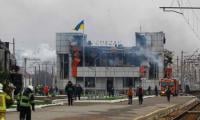TEHRAN: Flooding in southern Iran has killed at least 22 people and left one person missing following heavy rainfall in the largely arid country, a local official said on Saturday.
Iran has endured repeated droughts over the past decade, but also regular floods, a phenomenon made worse when torrential rain falls on sun-baked earth.
Videos posted on local and social media showed vehicles being carried away by the rising waters of the Roodball River in the southern province of Fars. One video showed adults pulling a child from a car as it began to shift downstream.
“The number of people killed has risen to 22 after another body was found,” due to floods that affected several towns in and around Estahban county, Javad Moradian, who heads a local rescue unit, said.
A Red Crescent official earlier put the death toll at 21, with two people missing.
The Governor of Estahban, Yousef Kargar, said: “Around 5:00 pm yesterday, heavy rains in the central parts of Estahban County led to flooding.”
The incident happened 174-km east of the provincial capital Shiraz on a summer weekend, when families tend to head to cooler areas, such as rivers, lakes and valleys.
“A number of local people and sightseers from other areas, who had gone to the riverside and were present in the river bed, were caught in the flood due to the rise in the water level,” Kargar added.
Iran’s first Vice President Mohammad Mokhber called on the governor of Fars province to open an investigation into the incident and “to compensate the families of the victims.”
Photos released by Iran’s Red Crescent Society showed rescue workers walking on cracked dry soil while others searched among reeds.
Interior Minister Ahmad Vahidi toured the region to monitor the rescue efforts.
The state news agency reported that a weather report put out by meteorologists in Fars warned there could be further strong rainfall ahead. In 2019, heavy rains in the country’s south left at least 76 people dead and caused damage estimated at more than $2 billion. In January, two people were initially reported killed in flash flooding in Fars when heavy rains hit the area, but the toll rose to at least eight there and elsewhere in Iran’s south.
Like other regional countries, Iran has suffered chronic dry spells and heatwaves for years, and these are expected to worsen.
Scientists say the climate change amplifies extreme weather, including droughts as well as the potential for the increased intensity of rain storms.
In the last few months, Iran has seen demonstrations against the drying up of rivers, particularly in the central and southwestern areas.
Last November, tens of thousands of people gathered in the parched riverbed of the country’s Zayandeh Rood River, which runs through the central city of Isfahan, to complain about drought and condemn the officials for diverting water.
Security forces fired tear gas when the protest turned violent and said they arrested 67 people.
Last week, the official media said the Iranian police had arrested several suspects for disturbing security after they protested against the drying up of a lake once regarded as the Middle East’s largest.
Lake Urmia, in the mountains of northwest Iran, began shrinking in 1995 due to a combination of prolonged drought and the extraction of water for farming and dams, according to the UN Environment Programme. In neighbouring Iraq in December, 12 people died in flash floods that swept through the north of that country following a severe drought.















